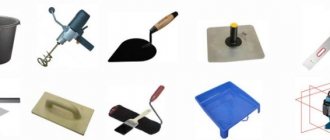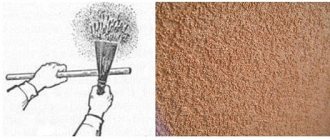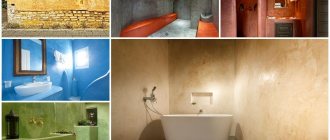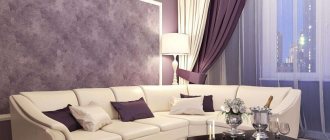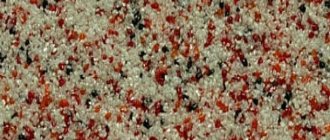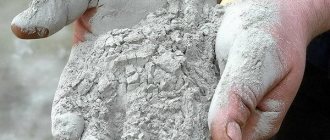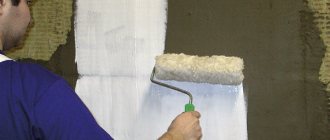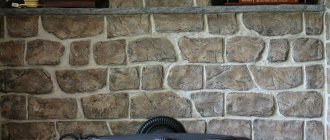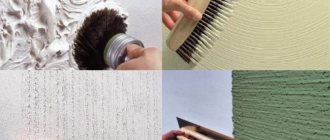They are intended for highly artistic finishing of surfaces with the creation of three-dimensional patterns or textured designs on a flat surface. Among the most technologically advanced samples, acrylic plaster should be mentioned. Acrylic plaster is intended for interior work and finishing the exterior walls of a house.
Composition of acrylic plaster
Acrylic plaster is a finishing material based on synthetic resins.
The composition includes the following substances:
- Acrylic resins , giving the finished surface elasticity and beautiful appearance;
- Modifiers that significantly increase technical characteristics;
- Dyes;
- Filler that gives a different texture to the wall.
This type of plaster goes on sale in finished form. The color palette is very diverse, it will not be difficult to choose the desired shade. Since dyes are added during manufacturing in strictly certain proportions, they do not affect the characteristics of the composition. Antiseptic additives may also be present. Thanks to them, the plaster becomes resistant to various fungi and mold.
Surface reinforcement
For reinforcement, a special reinforcing mesh treated with an alkaline composition is used . It is used to mechanically strengthen the plaster layer. Installation of the reinforcing mesh is carried out on an adhesive layer applied to the surface of the insulation (most often foam plastic), into which the mesh is slightly pressed to be completely immersed in the adhesive composition.
After this, or the same glue is applied This layer is made even, a notched trowel is not used, since the surface will be the basis for the finishing layer of acrylic plaster.
Reinforcement
This is interesting: Wenge furniture in the interior (52 photos): light and dark design
Characteristics of acrylic plaster
This type of finishing material has a large number of positive aspects. The strength and elasticity of the material is complemented by the following characteristics:
- Frost resistance and water-repellent qualities allow it to easily withstand any climatic conditions;
- Good air permeability allows the walls to “breathe”;
- The long service life allows you to maintain the appearance of the wall for up to 25 years;
- Combines perfectly with any mineral materials;
- A large color palette and the addition of dye during production ensure long-term color retention without changing the properties of the plaster;
- Easy application of the mixture allows for independent work without additional costs for paying specialists;
- Dries quickly, which reduces time wasting;
- Low price of acrylic plaster compared to silicone or silicate mixtures.
In addition, it repels dust and is easy to clean, making it suitable for use in highly contaminated environments, for example, when finishing industrial buildings.
Like any material, such plaster has its drawbacks. The main disadvantage is the flammability of such material. For this reason, caution is required when working with fire near an acrylic-treated wall.
Due to the large difference in operating conditions, a universal solution cannot exist. However, a large selection will help you find a solution for any case:
- Constantly high air humidity;
- Large temperature fluctuations throughout the day or year;
- Heavy dustiness in the air;
- Prolonged exposure to high ambient temperatures.
In addition, acrylic plaster is available in two types - for repair work and for decorative finishing of premises. Moreover, it can be for external work or for interior decoration.
The air temperature for working with such material must be at least 5 degrees. The time until complete drying is no more than 24 hours at an air temperature of 20 degrees. Depending on the additive fraction, the mixture consumption ranges from 1 to 4 kg/m2. It is worth paying attention that the larger the grain fraction, the higher the plaster consumption.
Advice from the experts
Experienced builders know how to avoid mistakes when working with acrylic elastic plaster. They advise:
- Do not start work when tired. It is better to wait until the person is healthy and well rested.
- It is better to start the process in the morning to do everything at once. This way you can avoid differences between the walls and achieve a uniform decorative layer.
- Do not forget about personal protective equipment to prevent the solution from getting into your eyes.
- It is better to apply it from a corner, distributing the acrylic composition over the wall.
- Drying should occur under natural conditions. There is no need to speed it up by using hair dryers, heaters or similar devices. This is fraught with the formation of cracks and destruction of the created layer.
- The optimal thickness of the acrylic layer is 2-3 mm. There is no need to make it thicker.
- The process is performed at temperatures from +5 to +25 degrees, wind and draft are not allowed. Humidity no more than 60%.
Acrylic plaster is a universal option that can be used to decorate a room inside and outside. Thanks to it, a unique appearance, Venetian gloss and modern design are created. And thanks to its characteristics, it will last for decades.
Types and features of material
First of all, it is worth noting that there are two types of decorative plaster – for external and for internal work. Facade plaster for exterior use is more resistant to climatic influences; it can also be slightly stronger than the mixture for interior decoration.
Based on the type of surface obtained, the following types of plaster are distinguished:
- Venetian;
- Mosaic;
- Structural;
- Textured mixture.
All these types can be used both indoors and outdoors. The only exception is Venetian plaster, which is used exclusively for interior decoration.
- Textured acrylic plaster
Fine crushed stone, mica, and flax fibers are used as additives. The finished wall's appearance can resemble leather, stone or wood. It can be made in the following variants: “bark beetle”, “fur coat”, “lamb”. These types differ in the filler fraction. This type of acrylic plaster is the most popular due to its lower cost.
- Structural acrylic plaster
Additives can be either quartz or marble chips. The relief depends on the filler fraction. The finer the fraction, the smoother the surface. Larger sizes will have a more grainy appearance.
- Mosaic acrylic plaster
Quartz or fine marble chips are used as an additive. Thanks to multi-colored granules, it does not require dyes. The finished wall surface will shimmer in the light.
- Venetian acrylic plaster
The surface is externally indistinguishable from marble. By adding dyes, the illusion of precious stones is created. It is possible to create both a matte and glossy effect, depending on the working technique. Visually enlarges the room, ideal for decorating small rooms.
Thus, various colors, textures and types of acrylic plaster allow it to be used in any design. You can choose the finishing for a reputable office, a country house, or a small city apartment.
Advantages and disadvantages
The advantages of this finishing material are much greater than the disadvantages. Consumers identify the following factors as the main disadvantages:
- high price. The material is environmentally friendly and consists of expensive ingredients that give the coating strength and a long service life;
- low level of vapor permeability. The film formed on the surface of the hardened layer has poor ability to transmit steam, which is why the walls practically do not “breathe”.
- poor resistance to ultraviolet radiation. The sun's rays have an adverse effect on the color scheme of the plaster layer. In this regard, acrylic plaster compositions are recommended to be used for finishing interior walls, covering them with coloring compositions on a similar basis in order to extend their service life;
- ability to accumulate static voltage. Debris and dust quickly accumulate on the surface, and you have to frequently tidy up the coating.
Now we list the advantages of acrylic decorative plaster:
- high strength index. The coating is able to withstand significant mechanical impacts that other plaster compositions cannot cope with;
- wear resistance. The plaster layer does not peel off or crumble, and stains do not appear on its surface due to friction. If all work is carried out correctly, the surface will last for decades, maintaining all the attractiveness of its appearance;
- the material is able to withstand temperature changes and exposure to a humid environment;
- The plaster mixture contains non-combustible materials. This composition is recommended for use for facade decoration insulated with flammable materials;
- the building material is produced ready for application;
- the mixture is easily applied to the surface of the walls, has plasticity, does not crack, does not form lumps. Even an inexperienced developer can work with such material.
Preparatory work before applying plaster
First of all, it is necessary to level the walls and repair cracks. Acrylic plaster is applied in a thin layer, even small irregularities will not be hidden. For leveling, use a cement compound or putty. If the wall is initially smooth and has no flaws, it must be cleaned of the previous finishing layer. After this, you need to clean off all dirt from the wall with a wire brush. If necessary, rinse with water and dry. Grease stains must be removed with degreasing agents.
Primer is a must when preparing walls, despite the good adhesion of plaster to any materials. The primer composition will clog the pores in the wall, so the surface will not absorb water from the composition. This will also help remove dust from the wall and improve adhesion.
Mechanized application
Construction companies use plastering machines for plastering large objects. Such machines, by mixing and spraying the plaster solution, draw air bubbles into it. As a result, the coating is warmer and sticks more reliably, and the mixture consumption is reduced. In private construction or renovation, you can use a plaster gun/hopper. After machine application, the laid layer is finalized by hand if a smooth surface or relief application is required using a roller or matrix.
When applying the solution mechanically, the use of eye protection is mandatory. If the plaster gets into your eyes, they should be rinsed with water.
Techniques for working with acrylic plaster
- Exterior finishing
After complete preparation of the walls, they proceed to the design of the facade. To do this, you only need a bucket of mixture and a spatula. It is important to protect your body and eyes from acrylic plaster. If this happens, you must immediately rinse your skin or eyes with water. On walls made of wood or covered with insulation, you need to additionally install a fiber optic mesh. It is not recommended to finish the façade of a house in bad weather. Rain can ruin all your efforts.
The wall must be divided into sections. In this case, the size of the area should be such that it can be plastered in one go. There should not be long breaks between processing different areas. In this case, the boundaries between areas plastered over a long period of time will be very noticeable. If you still had to stop and the edge of the applied composition dried out, it should be moistened with water. It is also allowed to moisten the surface of slightly dried plaster in a bucket with water. Water will help wash off the unsuccessfully applied layer from the wall. It is worth considering that the plastered wall must be protected from exposure to rain and excess moisture until the composition has completely dried.
Plaster can be applied by machine. This method is used on large objects. Due to constant mixing and enrichment of the composition with oxygen, the material receives additional fluffiness and consumption is reduced. The mixture sprays the plaster evenly over the wall. The layer will be more even, without seams. In this case, leveling is allowed by the rule. After complete drying, additional painting is allowed if necessary.
When decorating a façade manually, a layer not exceeding 2 millimeters should be applied. Start working from a corner over the entire area to another corner. After application and leveling, you should take care of the texture. If the surface does not need to be flat, you can use more than just special tools. You can use any available material. For example, if you press an even metal object against a fresh layer and then sharply pull it away, you will get “spines.” You need to let it cool for 10 - 15 minutes, after which, without pressing too hard, we smooth them in one direction along the entire wall. The result will be “rain”. You can first experiment on a small area using your imagination. You can use any objects that your imagination dictates - crumpled cellophane, a sponge, or make stains with a glove. Unsuccessful options can be washed off with water. It is recommended to rinse off before the mixture hardens. The only thing you should worry about in advance is to purchase additional amounts of plaster to experiment with texture.
It is better for two craftsmen to work with acrylic plaster. In this case, the first one applies and levels the material, and the second one applies the texture. No additional painting is required. If desired, you can sand the entire wall or individual fragments, cover it with wax, and paint it in different colors. Professional designers can create entire masterpieces from acrylic plaster.
- Interior decoration
This finishing material is used in the same way for interior decoration. The exception is the number of layers - to create a different design you may need more than one. Therefore, before work, it is worth clarifying the required amount of composition in order to avoid long breaks in work. It is also worth starting work in the morning, in good health.
There are also various application methods for interior decoration:
- Latex - plastic qualitatively imitates a marble or stone surface;
- Wet silk imitates a mother-of-pearl fabric surface;
- Sea Breeze has a translucent mother-of-pearl surface with the addition of fine sand.
This decoration looks good in the hallway. Excellent for the bathroom, as it is not afraid of high humidity. Its use is permissible in any room where there is no threat of fire. The environmental friendliness of the material allows you to decorate children's rooms with this composition.
There are some features of applying different types of plaster. Venetian, the most expensive and demanding. It is preferable to trust specialists. The plaster mesh should be installed, puttied and primed. Apply in several layers. Before applying structural acrylic plaster, it is necessary to treat the wall with a deep penetration primer. Adding color is unacceptable. Textured plaster is the most unpretentious to use. Does not require lengthy preparation of walls, easy to apply independently. The texture pattern can also be anything.
Painting applied acrylic plaster
A large color palette and durable elastic surface eliminate the need for mandatory painting of the plastered wall. However, a design decision may require painting the entire wall or sections of it. Non-waterproof water-based paint will look advantageous on embossed textured plaster. After complete drying, treat the painted surface with a damp sponge. The paint will be washed off a little from the protruding elements, its tone will be much lighter than in the recesses, which will give more volume to the texture. This painting method is suitable exclusively for interior work. For the design of the facade, if necessary, paint for external work, lek, wax and other similar materials are used.
Finishing process
Speaking about how to apply decorative plaster, it is worth emphasizing that the work is done quite simply and sometimes you may not even need the help of specialists. In order to apply plaster there is no need to level the walls and this is its advantage.
The design of this coating can be complex, for example, made in the Venetian style, or romantic and simpler. Only your capabilities and taste preferences are taken into account.
Painting plaster composition
Any aqueous compositions become less saturated in color after drying. This should be taken into account not only in relation to water-based paint. Acrylic plaster also becomes less saturated in color. Based on this, more color is added to this type of finishing material. The easiest way to obtain the required shade are programs that calculate the required amount of tinting paste for a certain volume of plaster. Such calculations will allow you to obtain the same shade for the entire wall area. Similar programs are installed in almost all large stores.
What is used to create any effect?
Almost all types of decorative plaster for walls can be applied using various tools. In the last few years, metal graters and trowels have been used.
Moreover, it is important to note that they can be used by craftsmen not only to apply the composition in a neat, even layer, but also to form a chaotic, geometric pattern on it.

